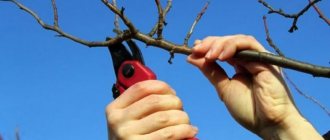Rose came to us from warmer countries where there are no long and harsh winters. For successful cultivation in our conditions, it is necessary first of all to resolve the issue of overwintering the plant in open ground. So that the touching words of the song hit of past years: “... the thorns are defenseless, what the snow and frost did to her...” - do not come true, we will tell you in detail about caring for roses in the fall, preparing them for winter.
If young roses and seedlings have taken root well, then there is a high probability of their successful wintering. Preparing for it is no fundamentally different from preparing “adult” roses for wintering.
Features of autumn rose care
At the beginning of spring and throughout the summer, caring for roses activates the development and flowering of the bush. All autumn activities are aimed at helping the plant stop its growing season before the arrival of frost. During this period, a change in the state of rose bushes occurs:
- The stems become coarser.
- Young shoots and buds practically do not develop.
- The process of accumulation of nutrients begins inside the root system.
- Metabolic processes slow down.
In this way, rose bushes naturally prepare for the coming of winter. What kind of care is needed for roses in the autumn? Let's figure it out further.
Trimming
To work with rose bushes, it is recommended to choose a clear day without wind or rain.
- Flower growers living in cold climates (Siberia, the Urals, St. Petersburg) prune roses in the second ten days of October.
- In central Russia, such work can begin at the end of October.
- In the southern regions, for example, in Kuban, this event can be postponed until early November.
It is very important to prune roses at air temperatures from -2 ْ to -4 ْС, not higher. The fact is that pruning itself pushes the plant to begin development. Young buds may begin to grow on the eve of frost, which will lead to disease or death of the bush. After pruning, the bushes need to be properly insulated to create good conditions in winter.
Correctly carried out procedures will provide the plant with increased frost resistance. Pruning old branches will give impetus to the development of young shoots in the spring. In addition, the buds will be larger.
It is necessary to treat not only adult plants, but also young bushes of the first year of life. This procedure should be carried out for all plants annually in the fall. But, there are types of roses that do not require pruning.
Pruning rules
There are some rules for pruning roses in the fall. These should be followed to get a high-quality plant with many buds:
- The shoots are cut at an angle of 45 degrees.
- Dry, diseased, pest-damaged shoots are removed.
- All unripe shoots are also removed.
- For work, you should use only a sharp and clean knife so as not to injure the plant.
Important! Immediately after pruning, the cut sites are treated with wood ash or any antiseptic. This will help reduce the risk of infection by harmful microorganisms.
Pruning for different types of roses
Depending on the type of rose, its size and intensity of development, you can choose the type of pruning in the autumn:
- Short (strong) pruning - the length of the branches is about 5-10 cm. They are practically cut off completely, leaving only 2-3 buds near the ground on each shoot.
- Medium (moderate) - the length of the branches is about 30-40 cm. When pruning the shoots, 5 buds are left from the ground. Dry and diseased branches are removed. With the arrival of spring warmth, the rose produces a lot of young shoots.
- Long (light) - branches 70-100 cm. Here, pruning is carried out only at the tips of the branches, on which at least 10 buds should remain.
Watch the video! How to prune roses for the winter and cover them
Features of pruning different types of roses
- In climbing rose , for example, in the Rambler variety, which bloom with small flowers, only the tips of the branches are cut off. Climbing types of roses with large flowers remove all faded stems, but leave 2-3 shoots from last season. The side shoots are cut off, leaving 10 cm, which should have 2-3 buds.
- The polyanthus type of roses is famous for its enhanced growth and lush flowering. Old and immature branches of the plant are cut off, and all the rest are shortened, leaving 3-4 buds on each. In polyanthus roses with small flowers, 2-3 buds are left when trimming strong shoots, and on weak shoots - up to 1-2 buds. This treatment promotes better development of the bush and active flowering.
- Hybrid tea roses do not require heavy pruning, as this may result in the development of new shoots without flowers. Therefore, when pruning, stems up to 30 cm in length with 5 buds are preserved. However, this type of pruning also does not lead to massive flowering of the bush.
Advice! If flowers appear on the top of the branches, but the lower part of the bush does not bloom, then you need to cut off all the old shoots and trim the rest short.
- Medium pruning in autumn is also carried out for such types of roses as grandiflora and remontant ones.
- The Pernetian rose variety is in many ways similar to the hybrid tea variety. In one and the other plant, flowers are formed at the ends of the shoots of one year of life. Therefore, in the autumn, they trim a third of the growth. Dry and damaged parts of the plant are cut off completely.
- Before planting, all branches of cascading standard roses are cut short to 15 cm from the ground. The next year and with each subsequent year, the old branches are cut shorter and shorter. The young shoots are left, slightly shortened.
- Floribunda roses have the ability to quickly grow to large sizes. For such branched plants, combined treatment of the bush is used. Half of the stems are cut short, the other half is shortened medium. The remaining side shoots are cut off, leaving only 2-3 buds on the shoot.
- Park roses undergo light pruning, leaving about 8-10 young buds on the stems. The same method is used for pruning rose varieties such as Bengal, English, and hybrid tea roses with large flowers. For Old English species and bush roses, the stems are cut back by two-thirds.
- Climbing roses , which can be divided into those that bloom once and repeatedly, require a special approach to such a procedure as pruning. So, the first ones form buds on last year’s branches. In autumn they are cut off, leaving young shoots. The latter produce buds on the main stems for three seasons, and in the fourth year, for the winter period . At the same time, be sure to leave 4-6 strong and healthy stems that are still capable of blooming.
Ground cover rose varieties are not pruned in the autumn. In order to sanitize the bushes, it is enough to remove old, damaged and dry branches. It is recommended to cut off all branches once every few years, leaving stumps up to 15 cm from the ground.
Top dressing
The time to feed the plant comes 2 weeks after pruning.
Important! Nitrogen fertilizers do not need to be added to the soil from the moment the rose begins to bloom until the end of the season. The fact is that after this feeding, active growth of green mass begins.
With the arrival of autumn, rose bushes are nourished with fertilizers such as:
- phosphorus;
- magnesium;
- potassium
They are necessary in order to strengthen the roots and young shoots of the crop before the onset of frost. In addition, they help restrain the development of the aboveground part of the plant.
To prepare fertilizer for 1 bucket of water take:
- Potassium sulfate, magnesium sulfate – 10 g each.
- Superphosphate - 25 g.
- Boric acid – 2.5 g.
The prepared solution is poured under the bush only after the soil around it has been thoroughly watered. A bucket of fertilizer solution is enough for 3-4 square meters. landing
For foliar feeding, the following components are required:
- for 3 buckets of water;
- potassium monophosphate -15g;
- superphosphate - 15 g.
On the 7th day after fertilizing, pinch the tops of the shoots so that the stems become woody faster.
Dry feeding
Today, many gardeners prefer to feed garden crops with folk remedies. Basically, two such remedies are used in the fall:
- wood ash, rich in potassium and phosphorus;
- banana peel, which is previously dried and ground into powder.
The soil under the bush is sprinkled with dry ash powder, but you can dilute it in water and pour the solution onto the ground.
Banana peels can be dried and crushed at home In this form they are mixed with the soil under the rose bushes. Fresh banana peels can also be used to feed the plant. In this case, it is buried in the root in early September. Before winter comes, the fruit waste will have time to rot.
Using these products, you can use a combined method of feeding roses.
Important! So that the last fertilizer is applied before the beginning of October, and in cold regions - until mid-September.
Potassium magnesium in the form of granules is used as this feeding and at the same time for disinfection. The soil around the roses is sprinkled with this product before covering the plant, in October-November.
Don't rush to cover!
Hiding too early is, as a rule, a manifestation of the gardener’s excessive care for his pets. For some reason, it is believed that roses are sissies that are afraid of even a slight cold snap. But this is not at all true! They tolerate frosts well down to -20-25 degrees, and can withstand significantly lower temperatures for a short time.
With a gradual decrease in air temperature, natural hardening of plants occurs, in whose tissues complex biochemical processes occur at this time. Premature covering interrupts them, depriving the shoots of natural light and disrupting the required temperature regime. In addition, autumn weather is often unstable; after frosts, thaws come, and conscientiously wrapped bushes simply damp out.
However, you should also not be late with winter protection of roses - if the temperature drops sharply, the shoots may suffer. Experienced gardeners carry out sheltering in stages, without covering the bushes completely until a stable negative air temperature has established and the soil has frozen.
Disease prevention in autumn
autumn, the active development of rot and harmful microorganisms that cause various diseases begins in open ground Insects, many of which are pests, settle in all parts of the bush for wintering. In the autumn, the plant is already in a weakened state, therefore it is very vulnerable. To help him, it is necessary to take some preventive measures:
- It is necessary to keep the area around the bushes clean. Constantly clear it of weeds, dry grass, leaves and other debris. Over time, all this rots and can infect not only the root system, but also the above-ground part of the bush.
- Promptly prune the bush from the lower leaves and shoots. They are the ones most susceptible to various diseases. From mid-September, work can be carried out to remove the lower shoots at least 30 cm from the root.
- After pruning the rose, you should treat it with a special product to prevent fungus from appearing. To do this, it is recommended to use iron sulfate, as well as a fungicide, a solution of which is prepared from powder according to the manufacturer’s recommendations. To prepare a 3% solution of iron sulfate, dissolve 300 g of the substance in 10 liters of water.
Fungus treatment
October is the most suitable month for taking preventive measures against various diseases and pests. In order to avoid the spread of spores, pruned shoots (including damaged ones) and fallen leaves must be collected and burned. The soil should be dug up; this action will provoke freezing of the fungus.
Spraying is also an effective method. Experienced flower growers know that parasites can adapt to even the lowest temperatures, and therefore flowers need protection. To prevent diseases, a 1%-3% solution of Bordeaux mixture is suitable. It is also recommended to spray the bushes and the soil around them with a solution of copper sulfate (3 - 5%).
Transplanting roses
It is best to replant roses in September - the first ten days of October. First of all, it is necessary to transplant bushes that, for whatever reason, are developing poorly, to a new location. New purchased roses are also planted in a suitable place in the fall. When transplanting rose bushes, you should follow certain rules:
- Choose a place on the site that is open and sunny.
- To plant roses, you must first prepare the holes. If there are a lot of bushes, make markings. A distance of 40-50 cm is made between small roses. Varieties of bush and climbing roses are planted at a distance of 1-1.5 meters between shoots. The holes are usually made in size - 50x50 cm.
- For transplantation you also need a nutrient mixture. To prepare it, take compost, peat and sand in equal quantities. You can add clay to the soil for the flower. It is recommended to add ash, bone meal and other nutritional elements to the resulting mixture.
- Before transplanting, seedlings need to be soaked. Then they are lowered into the hole, straightening the roots. After this, the hole is filled with soil and watered generously. When the water is completely absorbed into the ground, the bushes are spudded.
Important! The best time to replant roses is the end of October. First, the roots of the seedlings are shortened a little and holes of 50x50 cm are formed. The soil mixture is added to the prepared hole. After planting, roses are watered generously.
The rose should be replanted if it does not respond well to care in the warm season. You need to dig up a bush for replanting very carefully. The roots are then wrapped in natural fabric for storage or safe transportation. Before planting, the branches are cut by 2/3. A bush is placed in the prepared hole, the roots are straightened and covered with fertile soil.
How to take rose cuttings
Rose cuttings are cut as follows:
- Choose healthy mature shoots with a diameter of 4-5 mm.
- Cut them into small pieces so that each has 3-5 developed buds.
- The upper cut is made straight 2-3 cm above the upper bud, and the lower cut is made obliquely under the lower bud, so that you know which part to plant the cutting.
- For cutting, use a sharp instrument, which is disinfected with alcohol and boiling water.
Advice! When rooting a rose, there is no need to immediately remove the leaves; they will provide nutrition to the plant; only the lower leaves are removed.
Planting a rose from a cutting
After cutting, the cuttings are planted in a permanent place. This method is preferable, as the plant experiences less stress and takes root better. Autumn rooting of rose cuttings is carried out as follows:
- The cuttings are cut and treated with a root former (for example, Heteroauxin).
- Dig a hole 30 cm deep, fill 2/3 with grass and sprinkle with compost.
- The cuttings are planted at an angle of 45 degrees, leaving 1/3 of the shoot or 1-2 buds above the ground.
- Fill the hole and water it abundantly.
- How to cover rose cuttings for the winterSo that the planted cuttings survive until spring, they are covered with a plastic bottle in which several holes are made for air circulation. You can use a glass jar, then it needs to be raised slightly above ground level. Everything is sprinkled with leaves on top and covered with non-woven material. Pegs are driven in nearby to mark new plantings.
How to save rose cuttings in winter
If you plan to plant cuttings in the spring, then you need to take care of their safety in the winter. They do it like this:
- Dig a hole 15 cm deep in the garden, lay a covering woven material on the bottom, and lay cuttings without leaves on top at the same distance from each other. Pegs are driven in along the edges of the hole so as not to forget their location.
- Cover everything with the remaining cloth and sprinkle with soil.
- In the spring, when the snow melts, the cuttings are dug up and examined. On the “established” ones, callus appears - a thick growth on which roots are formed.
- The shoots are immediately planted in the cuttings or in a permanent place.
- If planting will take place in a day or more, the cuttings are placed in a container of water (it is better to add a few drops of Epin to it).
Sheltering roses for the winter
The list of autumn preparations for plants for winter frosts includes an important item - their shelter.
Preparation
- When preparing roses for shelter, after pruning they should be treated with a fungicide. You can also use iron sulfate and even diluted garden paint.
- Next, the bushes should be hilled to a height of 30 cm. This procedure will protect the plant’s rhizomes from frost. The area around the bush is cleared of weeds, dry leaves and debris. After this, the rose trunk is hilled up with soil to a height of 20 cm. At the same time, the root collar with the graft should be underground at a depth of about 5 cm.
- Now you can start covering the bushes. The type of shelter is chosen depending on the type of rose and the climatic conditions of the region. To insulate bushes for the winter, pine needles, dry leaves and sawdust, special structures and other suitable materials are used.
Important! Read more about how and what to properly cover roses for the winter.
Take care of ventilation
Often, conscientious but inexperienced gardeners have roses under cover that rot and die from excess humidity at relatively high temperatures. This is facilitated by:
- construction of sealed, water- and airtight shelters;
- lack of ventilation during prolonged thaws or spring warming;
- covering roses too early;
- covering bushes from which leaves have not been removed.
As a rule, this problem is most acute in those regions where the climate is unstable, and in winter frosts are interspersed with severe thaws. At this time, condensation forms under shelters made of water- and air-tight materials, causing mold and rot. If it is not possible to ventilate winter protective structures as needed, you should choose other shelter options.
However, breathable materials in such a situation are also not a panacea: for example, popular lutrasil or spunbond usually get wet during a thaw, and then, when the cold comes again, they freeze, forming a dense ice crust. The breathing of plants under it becomes difficult, and they also often die.
If such temperature changes in winter are typical for your area, and you cannot provide the necessary care for roses in the event of a thaw, give preference to frost-resistant varieties that do not require shelter and winter well under snow - for example, Canadian roses or floribunda roses, which are more resistant to frost.
Scheme for autumn rose care by month
The following describes step by step all the autumn work by month that must be carried out to properly prepare the bushes for wintering.
September
In the first month of autumn, you must adhere to the following rules:
- Stop trimming roses for bouquets.
- Reduce watering.
- Replace nitrogen fertilizers with potassium-phosphorus fertilizers.
It is also necessary to carry out the following work:
- Root feeding with potassium phosphate fertilizer. To do this, dry granules are scattered around the bush and lightly compacted into the soil. You can also water it with a liquid solution.
- Loosen the soil for the last time for the season. It is better to do this immediately after feeding, so that the last buds ripen faster.
- Water the bushes 2 times - at the beginning and at the end of the month. If September is rainy, then there is no need to water additionally.
- Weed the rose garden to reduce the risk of the bushes becoming infected with harmful microorganisms.
- Remove foliage from the bottom of the bushes to a height of 20-30 cm from the ground.
- Bare stems must be painted with garden varnish, water-based solution or any disinfectant. This is necessary to protect the bushes from rot and pests.
October
In the second month of autumn, you must adhere to the following rules:
- Stop loosening the soil under roses to reduce oxygen access to the roots.
- We stop watering and fertilizing.
- In rainy October, cover the rose garden with film and drain water from the roots.
- Spray and clean the bushes to prevent diseases.
It is also necessary to carry out the following work:
- Spray the bushes with 1% Bordeaux mixture to protect roses from bacteria and pests.
- Remove all leaves and bend unripe buds. Just bend it, since pruning can provoke the formation of new inflorescences, especially in warm weather.
- Shrub, miniature and heat-loving roses are pruned to the height of insulation. Standard and climbing varieties are pinched at the growth point, the branches are removed from the supports and laid on the ground.
- Roses that did not grow well are transplanted to a new location.
- New varieties are being planted.
November
The last work to prepare roses for winter is carried out in early November. At this time, they no longer carry out activities that could lead to sap flow in the trunks of roses (feeding, pruning, watering).
If the temperature outside remains consistently below zero for 7 days, you need to start covering your roses for the winter:
- Remove the debris, dig up the ground and hill up the bushes to a height of 30 cm. If the roses are removed from the supports and lie on the ground, a mound of earth 50 cm high is poured onto the root.
- They are building a shelter. This can be a bulk method, a frame method, etc. More details about this are written in the article: How and with what to properly cover roses for the winter: a step-by-step guide to covering for hybrid tea, climbing, standard, bush and park roses.
All the activities that are carried out in the fall to prepare roses for winter are not particularly difficult. Young gardeners can safely take on their implementation. By following all the rules, you can preserve flowers during the winter. And with the arrival of summer, the results of your labors will be visible - the magnificent blooming of beautiful roses.
Watch the video! Shelter of roses in the Urals and Siberia
Stopping the growing season
To prevent the plant from growing and preparing for winter hibernation in the garden, it needs to be brought to this on its own in the fall. In conditions of unstable climate and constant temperature changes and late winters, this measure is mandatory for all regions. Plants need to create conditions close to natural, under which they will gradually go into hibernation.
All new shoots - twigs, buds and shoots on stems and bushes must be pinched. Not just cut, but break. This method will not stimulate the bush to grow more luxuriantly. Broken ends will simply dry out on the bush naturally.
In mid-autumn, you need to do moisture-protection watering - moisten the soil well to a depth of 50 cm. This will serve as a barrier to frost and the earth will not crack.
Watering in the fall is kept to a minimum, and if it rains, the bushes must be covered with film to prevent water from getting under the roots.











